What Is Christ Passio in the Context of Art Histroy?

Christ Crowned with Thorns by Matthias Stom (c. 1633–1639) shows Jesus in his Passion as the "Lord of Patience" with the crown of thorns and scepter reed, being mocked by Roman soldiers.
In Christianity, the Passion (from the Latin verb patior, passus sum; "to endure, behave, endure", from which likewise "patience, patient", etc.)[1] is the short final period in the life of Jesus Christ.
Depending on ane'southward views, the "Passion" may include, amidst other events, Jesus' triumphal entry into Jerusalem, his cleansing of the Temple, his anointing, the Terminal Supper, Jesus' agony in the Garden, his arrest, his Sanhedrin trial, his trial before Pontius Pilate, his crucifixion and his death on Good Friday, his burying, and the resurrection of Jesus. Those parts of the four canonical Gospels that describe these events are known as the "Passion narratives". In some Christian communities, celebration of the Passion also includes remembrance of the sorrow of Mary, the female parent of Jesus, on the Friday of Sorrows.
The word passion has taken on a more than general awarding and now may also apply to accounts of the suffering and death of Christian martyrs, sometimes using the Latin form passio .[2]
Narratives co-ordinate to the four canonical Gospels [edit]
Accounts of the Passion are institute in the four canonical gospels, Matthew, Mark, Luke and John. Three of these, Matthew, Mark, and Luke, known equally the Synoptic Gospels, give similar accounts. The Gospel of John business relationship varies significantly.[three]
Scholars do not agree on which events surrounding the death of Jesus should be considered part of the "Passion narrative", and which ones just precede and succeed the bodily Passion narrative itself. For instance, Puskas and Robbins (2011) commence the Passion after Jesus' arrest and before his resurrection, thus but including the trials, crucifixion and decease of Jesus.[iii] In Pope Benedict XVI's Jesus of Nazareth: Holy Week (2011), the term "Passion" completely coincides with the crucifixion and expiry of Jesus; it does not include before events and specifically excludes the burying and resurrection.[4] Others such as Matson and Richardson (2014) accept a broader approach and consider the triumphal entry, the last supper, the trial earlier Pilate, the crucifixion, the burial, and the resurrection collectively as constituting the and then-called "Passion Week".[5]
Basic storyline [edit]
Taking an inclusive approach, the "Passion" may include:
- Triumphal entry into Jerusalem: some people welcome Jesus when he enters Jerusalem
- The Cleansing of the Temple: Jesus is angry and aggressive towards livestock merchants and coin-changers inside the Temple of Jerusalem.
- The conspiracy against Jesus by the Jewish Sanhedrin priests and the teachers of the police force,[6] [7] [eight] now known every bit Council Friday.[ citation needed ]
- The Anointing of Jesus by a adult female during a meal a few days before Passover. Jesus says that for this she will e'er be remembered.
- The Terminal Supper shared by Jesus and his disciples in Jerusalem. Jesus gives concluding instructions, predicts his betrayal, and tells them all to retrieve him.
- Jesus predicts the Deprival of Peter: on the path to Gethsemane after the repast, Jesus tells the disciples they will all fall away that night. After Peter protests he volition not, Jesus says Peter will deny him three times before the cock crows.
- The Agony in the Garden: subsequently that nighttime at Gethsemane, Jesus prays while the disciples balance. Luke 22:43–44 adds that Jesus was terrified, and sweating claret; withal, the oldest manuscripts of the Gospel of Luke exercise non incorporate these ii verses, the other three canonical gospels don't mention this event either, and diverse manuscripts contain these verses elsewhere, fifty-fifty in the Gospel of Matthew (suggesting repeated attempts at insertion); thus, most modernistic scholars consider this tradition a afterward Christian interpolation, probably to counter docetism.[9] [ten] [eleven]
- The Arrest of Jesus: then Judas Iscariot leads in either "a detachment of soldiers and some officials from the main priests and Pharisees"[12] (accompanied according to Luke'south Gospel past the main priests and elders),[xiii] or a "large crowd armed with swords and clubs, sent from the main priests and elders of the people,"[14] [15] which arrests Jesus; all his disciples run away. During the arrest in Gethsemane, someone (Peter according to John) takes a sword and cuts off the ear of the loftier priest's servant, Malchus.
- The Sanhedrin trial of Jesus at the loftier priest's palace, after that night. The arresting party brings Jesus to the Sanhedrin (Jewish supreme courtroom); according to Luke's Gospel, Jesus is beaten by his Jewish guards prior to his examination;[16] the court examines him, in the class of which, according to John'due south Gospel, Jesus is struck in the face past one of the Jewish officials;[17] the court determine he deserves to die. According to Matthew's Gospel, the courtroom and so "spat in his confront and struck him with their fists."[18] They then send him to Pontius Pilate. According to the synoptic gospels, the high priest who examines Jesus is Caiaphas; in John, Jesus is also interrogated by Annas, Caiaphas' father-in-law.
- The Denial of Peter in the courtyard outside the loftier priest's palace, the aforementioned time. Peter has followed Jesus and joined the mob awaiting Jesus' fate; they suspect he is a sympathizer, then Peter repeatedly denies he knows Jesus. All of a sudden, the erect crows and Peter remembers what Jesus had said.
- Pilate's trial of Jesus, early on forenoon. Pontius Pilate, the Roman governor of Judea, questions Jesus, merely cannot find any fault with him (according to some gospels, Pilate explicitly declares Jesus' innocence); yet, the Jewish leaders and the oversupply demand Jesus' death; Pilate gives them the pick of saving Barabbas, a criminal, or saving Jesus. In response to the screaming mob Pilate sends Jesus out to be crucified.
- The Style of the Cross: Jesus and two other convicts are forced to walk to their identify of execution. According to the Synoptics, Simon of Cyrene is forced to carry Jesus' cross, while John writes that Jesus carried his cross himself.
- The Crucifixion of Jesus: Jesus and the two other convicts are nailed to crosses at Golgotha, a hill outside Jerusalem, later morning through mid afternoon. Various sayings of Jesus on the cross are recorded in the gospels before he dies.
- The Burial of Jesus: the body of Jesus is taken downwardly from the cross and put in a tomb past Joseph of Arimathea (and Nicodemus according to John).
- The Resurrection of Jesus: Jesus rises from the dead, leaving behind an empty tomb and reportedly appearing to several of his followers.
Differences between the canonical Gospels [edit]
The Gospel of Luke states that Pilate sends Jesus to exist judged by Herod Antipas because as a Galilean he is under his jurisdiction. Herod is excited at start to encounter Jesus and hopes Jesus will perform a miracle for him; he asks Jesus several questions only Jesus does not answer. Herod and then mocks him and sends him back to Pilate after giving him an "elegant" robe to habiliment.[19]
All the Gospels relate that a human named Barabbas[xx] was released by Pilate instead of Jesus. Matthew, Mark and John have Pilate offer a selection between Jesus and Barabbas to the crowd; Luke lists no choice offered by Pilate, just represents the oversupply demanding his release.
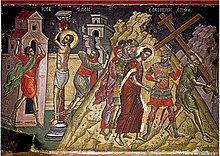
In all the Gospels, Pilate asks Jesus if he is King of the Jews and Jesus replies "And then you say". In one case condemned by Pilate, he was flogged before execution. The Approved Gospels, except Luke, record that Jesus is and then taken by the soldiers to the Praetorium where, according to Matthew and Marker, the whole contingent of soldiers has been called together. They place a majestic robe on him, put a crown of thorns on his head, and according to Matthew, put a rod in his mitt. They mock him by hailing him as "King of the Jews", paying homage and striking him on the head with the rod.
According to the Gospel of John, Pilate has Jesus brought out a second fourth dimension, wearing the purple robe and the crown of thorns, in order to appeal his innocence before the oversupply, saying Ecce homo, ("Behold the man"). But, John represents, the priests urge the crowd to demand Jesus' expiry. Pilate resigns himself to the conclusion, washing his hands (according to Matthew) before the people equally a sign that Jesus' claret will not exist upon him. According to the Gospel of Matthew they replied, "His blood be on us and on our children!"[21]
Mark and Matthew record that Jesus is returned his own dress, prior to being led out for execution. Co-ordinate to the Gospel accounts he is forced, similar other victims of crucifixion, to drag his own cantankerous to Golgotha,[22] the location of the execution. The three Synoptic Gospels refer to a man called Simon of Cyrene who is fabricated to carry the cross (Marking 15:21, Matthew 27:32, Luke 23:26), while in the Gospel of John (19:17) Jesus is made to deport his own cross. The Gospel of Mark gives the names of Simon's children, Alexander and Rufus. However, the Gospel of Luke refers to Simon carrying the cantankerous after Jesus, in that it states: "they laid hold upon one Simon, a Cyrenian, coming out of the country, and on him they laid the cross, that he might bear it later Jesus".[23] Luke adds that Jesus' female followers follow, mourning his fate, but that he responds by quoting Hosea 10:8.
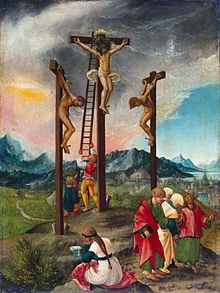
The Synoptic Gospels land that on arrival at Golgotha, Jesus is offered vino laced with myrrh to lessen the pain, but he refuses it. Jesus is then crucified, according to Mark, at "the third hour" (9 a.m.) the morning time after the Passover meal, but according to John he is handed over to be crucified at "the 6th hour" (noon) the 24-hour interval before the Passover meal, although many resolve this past proverb that the Synoptics use Jewish fourth dimension, and that John uses Roman time. Pilate has a plaque fixed to Jesus' cross inscribed, (co-ordinate to John) in Hebrew, Greek and Latin – Iesus Nazarenus King Iudeorum,[24] meaning Jesus of Nazareth, King of the Jews. Marking has the plaque say only, Male monarch of the Jews. The Gospels then land that the soldiers split Jesus' wearing apparel among themselves, except for one garment for which they cast lots. The Gospel of John claims that this fulfills a prophecy from Psalms 22:18. Some of the crowd who have been following taunt Jesus, maxim "He trusts in God; permit God deliver him now!", and advise that Jesus might perform a phenomenon to release himself from the cross.
Co-ordinate to the Gospels, 2 thieves are also crucified, one on each side of him. According to Luke, 1 of the thieves reviles Jesus, while the other declares Jesus innocent and begs that he might be remembered when Jesus comes to his kingdom (come across Penitent thief).
John records that Mary, his female parent, and two other women stand by the cross as does a disciple, described every bit the ane whom Jesus loved. Jesus commits his mother to this disciple's intendance. Co-ordinate to the synoptics, the sky becomes nighttime at midday and the darkness lasts for three hours, until the ninth hour when Jesus cries out Eloi, Eloi, lama sabachthani? ("My God, my God, why have you forsaken me?").[25] The centurion standing guard, who has seen how Jesus has died, declares Jesus innocent (Luke) or the "Son of God" (Matthew, Mark).
John says that, every bit was the custom, the soldiers come and break the legs of the thieves, and so that they volition dice faster, simply that on coming to Jesus they find him already dead. A soldier pierces his side with a spear.
Co-ordinate to the Gospel of Matthew, Judas, the betrayer, is filled with remorse and tries to render the coin he was paid for betraying Jesus. When the high priests say that that is his matter, Judas throws the money into the temple, goes off, and hangs himself.[26] Notwithstanding, according to the Book of Acts 1:18, Judas was non remorseful, took the money and bought a field from it, whereupon he of a sudden fell and died.
Narrative according to the Gospel of Peter [edit]
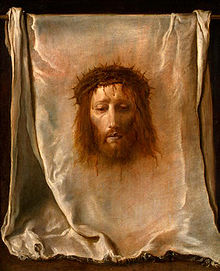
Farther claims apropos the Passion are made in some non-approved early writings. Some other passion narrative is found in the fragmentary Gospel of Peter, long known to scholars through references, and of which a fragment was discovered in Cairo in 1884.
The narrative begins with Pilate washing his hands, equally in Matthew, but the Jews and Herod refuse this. Joseph of Arimathea, before Jesus has been crucified, asks for his body, and Herod says he is going to take it down to comply with the Jewish custom of non leaving a dead body hung on a tree overnight. Herod then turns Jesus over to the people who drag him, give him a regal robe, crown him with thorns, and beat and flog him.
There are besides two criminals, crucified on either side of him and, as in Luke, one begs Jesus for forgiveness. The writer says Jesus is silent as they crucify him, "...every bit if in no pain."[27] Jesus is labeled the King of Israel on his cross and his clothes are divided and gambled over.
Equally in the canonical Gospels, darkness covers the country. Jesus is also given vinegar to drinkable. Peter has "My Ability, My Ability, why have you forsaken me?" as the last words of Jesus, rather than "My God, My God, why have you forsaken me?" equally quoted in Marker. He is then "taken up", mayhap a euphemism for death or maybe an innuendo to heaven.[28] Peter and so has a resurrection, similar to the other books.
Serapion of Antioch urged the exclusion of the Gospel of Peter from the Church because Docetists were using it to eternalize their theological claims, which Serapion rejected.[29] Many modernistic scholars likewise refuse this conclusion, equally the statement most Jesus beingness silent "as if in no hurting" seems to exist based on Isaiah's clarification of the suffering servant, "as a sheep that before its shearers is silent, so he opened non his rima oris." (Isaiah 53:seven).[28]
The Trials of Jesus [edit]
The gospels provide differing accounts of the trial of Jesus. Mark describes ii separate proceedings, one involving Jewish leaders and one in which the Roman prefect for Judea, Pontius Pilate, plays the key role. Both Matthew and John's accounts generally support Marker'southward two-trial version. Luke, alone amidst the gospels, adds yet a third proceeding: having Pilate send Jesus to Herod Antipas. The non-canonical Gospel of Peter describes a single trial scene involving Jewish, Roman, and Herodian officials.
Biblical prophecies [edit]
Onetime Attestation prophecy [edit]
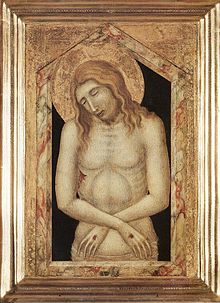
Christians interpret at to the lowest degree three passages of the One-time Testament as prophecies about Jesus' Passion.
The first and most obvious is the 1 from Isaiah 52:13–53:12 (either 8th or 6th century BC). This prophetic oracle describes a sinless human who will atone for the sins of his people. By his voluntary suffering, he will save sinners from the simply penalty of God. The death of Jesus is said to fulfill this prophecy. For example, "He had no form or comeliness that nosotros should look at him, and no beauty that we should desire him. He was despised and rejected past men; a man of sorrows, and acquainted with grief; and equally one from whom men hibernate their faces he was despised, and nosotros esteemed him not. Surely he has borne our griefs and carried our sorrows; notwithstanding nosotros esteemed him stricken, smitten by God, and afflicted. But he was wounded for our transgressions, he was hobbling for our iniquities; upon him was the chastisement that fabricated us whole, and with his stripes we are healed" (53:2–5).
The second prophecy of Christ'southward Passion is the ancient text which Jesus himself quoted, while he was dying on the cross. From the cantankerous, Jesus cried with a loud voice, Eli, Eli, lema sabachthani? which ways, "My God, my God, why hast Chiliad forsaken me?" These words of Jesus were a quotation of the ancient HE. King David, in Psalm 22, foretold the sufferings of the messiah. For example, "I am a worm and no human, the reproach of men and the outcast of the people. All who run across me, express joy me to scorn, they describe apart their lips, and wag their heads: 'He trusts in the Lord: let him costless him, let him deliver him if he loves him.' Stand not far from me, for I am troubled; be thou near at hand: for I have no helper. ...Yea, dogs are circular about me; a company of evildoers encircle me; they accept pierced my easily and feet – I can count all my bones – they stare and gloat over me; they split up my garments among them, and for my raiment they cast lots" (Psalm 22:7–nineteen). The words "they have pierced my hands and feet" are disputed, however.
The third master prophecy of the Passion is from the Book of the Wisdom of Solomon. Protestant Christians identify information technology in the Apocrypha, Roman Catholics and Eastern Orthodox among the deuterocanonical books. Just it was written almost 150 BC, and many accept understood these verses (12–20 of chapter ii) as a direct prophecy of Jesus' Passion. For example, "Permit united states lie in wait for the just, because he is not for our plough. ...He boasteth that he hath the knowledge of God, and calleth himself the son of God ... and glorieth that he hath God for his male parent. Permit united states of america see then if his words be true. ...For if he be the true son of God, he will defend him, and will deliver him from the easily of his enemies. Let us examine him by outrages and tortures. ...Let us condemn him to a well-nigh shameful expiry. ...These things they idea, and were deceived, for their own malice blinded them" (Wisdom ii:12–20).
In addition to the above, information technology deserves to exist mentioned that at least three other, less elaborate messianic prophecies were fulfilled in Jesus' crucifixion, namely, the following Old Testament passages:
"Many are the afflictions of the merely man; but the Lord delivers him from all of them. He guards all his bones: non even one of them shall exist cleaved" (Psalm 34:20).
"And they gave me gall for my nutrient, and in my thirst they gave me vinegar to drink" (Psalm 69:21).
"And they shall look upon me whom they have pierced; and they shall mourn for him as 1 mourneth for an only son; and they shall grieve over him, equally the manner is to grieve for the expiry of the firstborn" (Zechariah 12:10).
New Testament prophecy [edit]

The Gospel explains how these old prophecies were fulfilled in Jesus' crucifixion.
"And then the soldiers came and broke the legs of the starting time, and of the other who had been crucified with Jesus; but when they came to Jesus and saw that he was already dead, they did not intermission his legs. But ane of the soldiers pierced his side with a spear, and at in one case there came out claret and water. ...For these things took place that the scripture might be fulfilled, 'Not a bone of him shall be broken.' And again another scripture says, 'They shall wait on him whom they accept pierced'" (John 19:32–37).
In the Gospel of Mark, Jesus is described as prophesying his own Passion and his Resurrection three times:
- On the manner to Caesarea Philippi, predicting that the Son of Man will be killed and rise inside 3 days.
- Afterwards the transfiguration of Jesus, again predicting that the Son of Human being volition exist killed and rise within 3 days.
- On the style to Jerusalem, predicting that the Son of Man will be delivered to the leading Pharisees and Sadducees, exist condemned to decease, delivered to the Gentiles, mocked, scourged, killed, and rising inside three days.
Christians argue that these are cases of 18-carat and fulfilled prophecy and many scholars come across Semitic features and tradition in Mark nine:31.[30]
Afterwards the third prophecy, the Gospel of Mark states that the brothers James and John enquire Jesus to be his left and correct hand men, but Jesus asks if they can drinkable from the "cup" he must drink from. They say that they can exercise this. Jesus confirms this, but says that the places at his right and left paw are reserved for others. Many Christian see this as beingness a reference to the 2 criminals at Jesus' crucifixion, thus relating to the Passion. The "cup" is sometimes interpreted as the symbol of his death, in the low-cal of Jesus' prayer at Gethsemane "Let this cup be taken from me!"
Liturgical apply [edit]
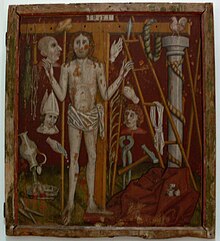
Holy Week [edit]
Most Christian denominations volition read one or more than narratives of the Passion during Holy Week, especially on Good Fri. In the Roman Catholic church, a large cross depicting the crucified Christ is brought out into the church and each of the faithful come forward to venerate the cross. Rather than having the Gospel read solely by the priest, whole Roman Catholic congregations participate in the reading of the Passion Gospel during the Palm Sunday Mass and the Proficient Friday service. These readings have the Priest read the part of Christ, a narrator read the narrative, other reader(due south) reading the other speaking parts, and either the choir or the congregation reading the parts of crowds (i.eastward.: when the crowd shouts "Crucify Him! Excruciate Him!").[31]
In the Eastern Orthodox and Greek-Catholic Churches, the Matins service for Good Fri is called Matins of the Twelve Passion Gospels, and is remarkable for the interspersing of twelve readings from the Gospel Book detailing chronologically the events of the Passion – from the Last Supper to the burying in the tomb – during the form of the service. The first of these twelve readings is the longest Gospel reading of the unabridged liturgical year. In addition, every Wednesday and Friday throughout the twelvemonth is defended in part to the commemoration of the Passion.[32]
During Holy Week/Passion Week Congregations of the Moravian Church (Herrnhuter Bruedergemeine) read the entire story of Jesus' concluding week from a Harmony of the Gospels prepared for that purpose since 1777. Daily meetings are held, some times two or three times a day, to follow the events of the 24-hour interval. During the class of the reading, the Congregation sings hymn verses to answer to the events of the text.
Most liturgical churches hold some class of celebration of the Crucifixion on the afternoon of Skilful Friday. Sometimes, this volition accept the form of a vigil from noon to iii:00 pm, the guess fourth dimension that Jesus hung on the cross. Sometimes at that place will be a reenactment of the Descent from the Cross; for instance, at Vespers in the Byzantine (Eastern Orthodox and Greek-Catholic) tradition.
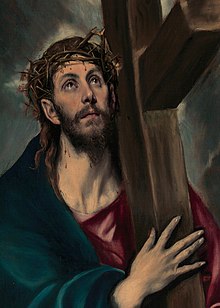
El Greco'southward Jesus Conveying the Cross, 1580.
Reparation to Jesus [edit]
The Roman Cosmic tradition includes specific prayers and devotions every bit "acts of reparation" for the sufferings and insults that Jesus endured during his Passion. These "acts of reparation to Jesus Christ" do not involve a petition for a living or deceased beneficiary, merely aim to repair the sins confronting Jesus. Some such prayers are provided in the Raccolta Catholic prayer volume (approved by a Decree of 1854, and published by state of the vatican city in 1898) which also includes prayers every bit Acts of Reparation to the Virgin Mary.[33] [34] [35] [36]
In his encyclical Miserentissimus Redemptor on reparations, Pope Pius Xi called acts of reparation to Jesus Christ a duty for Catholics and referred to them every bit "some sort of bounty to be rendered for the injury" with respect to the sufferings of Jesus.[37]
Pope John Paul Two referred to acts of reparation as the "unceasing endeavor to stand up beside the endless crosses on which the Son of God continues to be crucified".[38]
Devotions [edit]
Several non-liturgical devotions have been developed by Christian faithful to commemorate the Passion.
The Stations of the Cross [edit]
The Stations of the Cantankerous are a series of religious reflections describing or depicting Christ carrying the cross to his crucifixion. Near Roman Cosmic churches, as well as many Anglican, Lutheran, and Methodist parishes, contain Stations of the Cantankerous, typically placed at intervals forth the sidewalls of the nave; in most churches, they are small plaques with reliefs or paintings, although in others they may be elementary crosses with a numeral in the middle.[39] [40] The tradition of moving around the Stations to commemorate the Passion of Christ began with Francis of Assisi and extended throughout the Roman Catholic Church in the medieval menstruation. Information technology is about commonly done during Lent, especially on Good Friday, merely information technology can be done on other days equally well, especially Wednesdays and Fridays.
The Passion Offices [edit]
The Passion Offices were the special prayers said by diverse Roman Cosmic communities, particularly the Passionist fathers to commemorate the Passion of Christ.[41]
The Little Office of the Passion [edit]
Some other devotion is the Little Office of the Passion created past Francis of Assisi (1181/82–1226). He ordered this part around the medieval association of five specific moments in Jesus' Passion with specific hours of the twenty-four hour period. Having and then attributed these to hours of the Divine Role, he arrived at this schema:[42]
- Compline – 21:00 – Jesus' Arrest on the Mount of Olives
- Matins – 00:00 – Jesus' Trial earlier the Jewish Sanhedrin
- Prime – 06:00 – "an interlude celebrating Christ as the light of the new day"[42]
- Terce – 09:00 – Jesus' Trial earlier Pontius Pilate
- Sext – 12:00 – Jesus' Crucifixion
- None – 15:00 – Jesus' Death
- Vespers – 18:00 – "recalling and celebrating the unabridged daily cycle"[42]
In the arts [edit]
Visual art [edit]

Each episode of the Passion, such as the Flagellation of Christ or Entombment of Christ, has been represented thousands of times and has developed its own iconographic tradition; the Crucifixion is much the most common and of import of these subjects. The Passion is oft covered past a cycle of depictions; Albrecht Dürer's print cycles were so popular that he produced three different versions. Andachtsbilder is a term for devotional subjects such as the Man of Sorrows or Pietà, that may non precisely represent a moment in the Passion just are derived from the Passion story. The Arma Christi, or "Instruments of the Passion" are the objects associated with Jesus' Passion, such as the cross, the Crown of Thorns and the Spear of Longinus. Each of the major Instruments has been supposedly recovered every bit relics which have been an object of veneration among many Christians, and take been depicted in art. Veronica'south Veil is likewise often counted amidst the Instruments of the Passion; like the Shroud of Turin and Sudarium of Oviedo it is a fabric relic supposed to have touched Jesus.
In the Roman Catholic Church building (and some Anglo-Cosmic and Western Rite Orthodox churches), the Passion story is depicted in the Stations of the Cantankerous (via crucis, also translated more literally as "Way of the Cantankerous"). These 14 stations depict the Passion from the sentencing by Pilate to the sealing of the tomb, or with the addition of a 15th, the resurrection. Since the 16th-century representations of them in various media have busy the naves of near Catholic churches. The Way of the Cantankerous is a devotion practiced by many people on Fridays throughout the year, most importantly on Skillful Friday. This may be merely by going round the Stations in a church, or may involve large-scale re-enactments, as in Jerusalem. The Sacri Monti of Piedmont and Lombardy are similar schemes on a far larger scale than church Stations, with chapels containing large sculpted groups arranged in a hilly mural; for pilgrims to tour the chapels typically takes several hours. They generally date from the belatedly 16th to the 17th century; well-nigh describe the Passion, others different subjects equally well.
Music [edit]
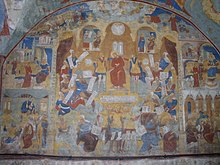
The main traditional types of church music sung during Holy Week are "Passions", musical settings of the Gospel narratives, both a Catholic and Lutheran tradition, and settings of the readings and responses from the Catholic Tenebrae services, peculiarly those of the Lamentations of Jeremiah the Prophet. The many settings of the Stabat Mater or musical settings of sayings of Jesus on the cross are as well commonly performed.
The reading of the Passion section of i of the Gospels during Holy Week dates back to the fourth century. Information technology began to be intoned (rather than only spoken) in the Heart Ages, at least every bit early on equally the 8th century. 9th-century manuscripts have "litterae significativae" indicating interpretive chant, and afterward manuscripts begin to specify exact notes to be sung. Past the 13th century, different singers were used for different characters in the narrative, a do which became adequately universal past the 15th century, when polyphonic settings of the turba passages began to appear also. (Turba, while literally meaning "crowd", is used in this case to mean any passage in which more than one person speaks simultaneously.)
In the subsequently 15th century a number of new styles began to emerge:
- Responsorial Passions prepare all of Christ's words and the turba parts polyphonically.
- Through-composed Passions were entirely polyphonic (also chosen motet Passions). Jacob Obrecht wrote the earliest extant example of this type.
- Summa Passionis settings were a synopsis of all four Gospels, including the Vii Last Words (a text later set up by Haydn and Théodore Dubois). These were discouraged for church use but circulated widely yet.
In the 16th century, settings similar these, and further developments, were created for the Catholic Church by Victoria, William Byrd, Jacobus Gallus, Francisco Guerrero, Orlando di Lasso, and Cypriano de Rore.
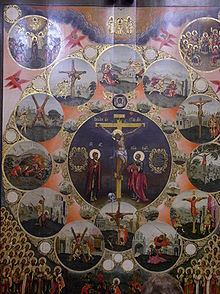
Martin Luther wrote, "The Passion of Christ should non be acted out in words and pretense, but in real life." Despite this, sung Passion performances were common in Lutheran churches right from the start, in both Latin and German, showtime every bit early every bit Laetare Sunday (three weeks before Easter) and continuing through Holy Week. Luther's friend and collaborator Johann Walther wrote responsorial Passions which were used as models by Lutheran composers for centuries, and "summa Passionis" versions continued to circulate, despite Luther's express disapproval. Afterwards 16th-century passions included choral "exordium" (introduction) and "conclusio" sections with additional texts. In the 17th century came the development of "oratorio" passions which led to Johann Sebastian Bach's Passions, accompanied past instruments, with interpolated texts (and so called "madrigal" movements) such as sinfonias, other Scripture passages, Latin motets, chorale arias, and more. Such settings were created by Bartholomäus Gesius and Heinrich Schütz. Thomas Strutz wrote a Passion (1664) with arias for Jesus himself, pointing to the standard oratorio tradition of Schütz, Carissimi, and others, although these composers seem to have thought that putting words in Jesus' mouth was beyond the stake. The exercise of using recitative for the Evangelist (rather than plainsong) was a evolution of court composers in northern Germany and only crept into church building compositions at the end of the 17th century. A famous musical reflection on the Passion is Part II of Messiah, an oratorio past George Frideric Handel, though the text hither draws from Old Testament prophecies rather than from the gospels themselves.
The best known Protestant musical settings of the Passion are by Johann Sebastian Bach, who wrote several Passions, of which 2 take survived, one based on the Gospel of John (the St John Passion), the other on the Gospel of Matthew (the St Matthew Passion). His St Mark Passion was reconstructed in various ways. The Passion continued to be very pop in Protestant Federal republic of germany in the 18th century, with Bach'due south 2nd son Carl Philipp Emanuel composing over twenty settings. In the 19th century, with the exception of John Stainer's The Crucifixion (1887), Passion settings were less pop, but in the 20th century they take once again come into fashion. Two notable settings are the St. Luke Passion (1965) by Polish composer Krzysztof Penderecki and the Passio (1982) past Estonian composer Arvo Pärt. Contempo examples include The Passion According to St. Matthew (1997), past Marking Alburger, and The Passion According to the Four Evangelists, by Scott King. Andrew Lloyd Webber's Jesus Christ Superstar (book and lyrics by Tim Rice) and Stephen Schwartz's Godspell both contain elements of the traditional passion accounts. Choral meditations on aspects of the suffering through which Christ humbled himself on the cross include arrangements such as Buxtehude'southward 1680 limerick Membra Jesu Nostri, the first such Lutheran treatment, incorporating lyrics excerpted from a medieval Latin poem and featuring Former Testament verses that prefigure the Messiah as suffering servant: run into Passion cantata.
Drama and processions [edit]
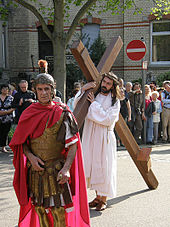
Christian Easter passion procession in Stuttgart, Germany

Not-musical settings of the Passion story are generally called Passion plays; these take been very widely performed in traditionally Catholic countries, oft in churches equally liturgical dramas – for versions with musical settings, see the previous section. 1 famous cycle is performed at intervals at Oberammergau Deutschland, another in Sordevolo one of the most important in Italy, and some other in the Brazilian state of Pernambuco uses what is considered the largest open-air theater in the world. The Passion figures among the scenes in the English mystery plays in more than one cycle of dramatic vignettes. In the Chester Mystery Plays' portrayal of Christ'southward Passion, specifically his humiliation before his sentence to crucifixion, the accounts of the Gospels concerning the physical violence visited on Jesus during his trial before the Sanhedrin, and the humiliating crowning of thorns visited upon him in Pilate's palace (or by Herod's soldiers, according to Luke), is further confused by showing both actions as being carried out by jeering Jews.[43]
Processions on Palm Sunday ordinarily re-enact to some degree the entry of Jesus to Jerusalem, traditional ones often using special wooden donkeys on wheels. Holy Week in Spain retains more than traditional public processions than other countries, with the most famous, in Seville, featuring floats with carved tableaux showing scenes from the story.
In Latin America [edit]
During the Passion week many towns in Mexico accept a representation of the passion.
In Spain [edit]
During the Passion week many cities and towns in Spain have a representation of the Passion.
Many Passion poems and prose text circulated in the fifteenth-century Castile, amidst which there were the showtime modern translations of before Latin Passion texts and Vitae Christi, and also a popular Monotessaron or Pasión de l'eterno principe Jesucristo attributed to a pseudo-Gerson. It was most probable written by Thomas à Kempis, whose Fake of Christ mentions the Passion a few times, uniquely when talking about the Eucharist.[44]
Picture [edit]
There have also been a number of films telling the passion story, with a prominent case existence Mel Gibson's 2004 The Passion of the Christ.
Other traditions [edit]
- The sons of Simon of Cyrene are named equally if they might have been early Christian figures known to Mark's intended audience (Brown et al. 628). Paul also lists a Rufus in Romans xvi:13.
- Nearly garments of the region were made of woven strips of material that were most viii inches wide and included decorative braids from two to four inches (102 mm) wide. The garments could exist disassembled and the strips of textile were often recycled. A unmarried garment might hold sections of many unlike dates. Yet, in Damascus and Bethlehem cloth was woven on wider looms, some Damascene being 40 inches (1,000 mm) wide. Traditional Bethlehem material is striped like pajama material.[45] It would thus appear that Jesus' "seamless robe" was made of material from either Bethlehem or Damascus.
- A tradition linked to icons of Jesus holds that Veronica was a pious adult female of Jerusalem who then gave her kerchief to him to wipe his brow. When he handed it dorsum to her, the epitome of his confront was miraculously impressed upon it.
Passion of Jesus in botany [edit]

The tropical plant passiflora, introduced to Europe in the 16th century, got its name from the Jesuit F B Ferrari, who saw in its flower an emblem containing the instruments of the Passion of Christ. The 3 stigmas represent iii nails, a circle of radial filaments - a encarmine crown of thorns, a stalk fruit grower - the Holy Grail, five anthers - five wounds of the Savior, a three-bladed leaf - holy Lance, the tendrils correspond the whips used in the flagellation of Christ, attachments (antennae) - lashes, white - the Savior'south innocence, etc.[46] [47]
See also [edit]
- Acts of Reparation to Jesus Christ
- Jesus at Herod's court
- Life of Jesus in the New Testament
- Passion cantata
- Sacri Monti of Piedmont and Lombardy
- Instruments of the Passion
- Christian tragedy
References [edit]
Citations [edit]
- ^ Cassell's Latin Dictionary, Marchant, J. R. V., & Charles, Joseph F., (Eds.), Revised Edition, 1928, p.396
- ^ Sheingorn, Pamela (1 Jan 1995). The Book of Sainte Foy. University of Pennsylvania Press. p. 3. ISBN0812215125.
- ^ a b Puskas, Charles B.; Robbins, C. Michael (2011). An Introduction to the New Testament, Second Edition. Wipf and Stock Publishers. pp. 122, 129. ISBN9781621893318 . Retrieved 26 Oct 2019.
- ^ Benedict 16, Pope (2011). "Chapter 8: Crucifixion and Burial of Jesus". Jesus of Nazareth: Holy Week: From the Entrance Into Jerusalem To The Resurrection. San Francisco: Ignatius Printing. ISBN9781681492766 . Retrieved 26 October 2019.
- ^ Matson, David Lertis; Richardson, K.C. (2014). One in Christ Jesus: Essays on Early Christianity and "All That Jazz," in Honor of S. Scott Bartchy. Wipf and Stock Publisher. p. 114. ISBN9781625641748 . Retrieved 26 October 2019.
- ^ Matthew 26:3–5
- ^ Marker 14:ane
- ^ Luke 22:2–5
- ^ Aland, Kurt; Aland, Barbara (1995). The Text of the New Testament: An Introduction to the Critical Editions and to the Theory and Do of Modern Textual Criticism . Erroll F. Rhodes (trans.). Grand Rapids: William B. Eerdmans Publishing Visitor. p. 310. ISBN978-0-8028-4098-one.
- ^ Bruce One thousand. Metzger, The Text of the New Testament: Its Manual, Corruption, and Restoration (Oxford University Printing: 2005), p. 286.
- ^ Bart D. Ehrman, The Orthodox Corruption of Scripture (Oxford University Printing: 1993), pp. 187–194
- ^ John 18:3
- ^ Luke 22:52
- ^ Matthew 26:48
- ^ Marking fourteen:43
- ^ Luke 22:63
- ^ John 18:22
- ^ Matthew 26:67
- ^ Luke 23:8–12
- ^ Bar-abbas means son of Abbas, the Lord. Some manuscripts of Matthew say "Jesus Barabbas", suggesting that an early version of the story assorted the fate of two men both named Jesus
- ^ Matthew 27:25
- ^ The meaning of Golgotha is "place of a skull."
- ^ "Bible gateway Luke 23:26". Biblegateway.com. Retrieved 2012-06-05 .
- ^ The original Greek of the Gospels reads Ἰησοῦς ὁ Ναζωραῖος ὁ Bασιλεὺς τῶν Ἰουδαίων, "Jesus the Nazarene, King of the Jews".
- ^ Mark reports Jesus says Eloi, Eloi, lama sabachthani? in Aramaic; Matthew reports Eli, Eli....
- ^ Matthew 27
- ^ Miller 1994, p. 403. This is the passage that was condemned as peradventure leading to Docetism.
- ^ a b Miller 1994, p. 403
- ^ Brown, p. xi harvnb error: no target: CITEREFBrown (assist) [ full citation needed ]
- ^ Brown, p. 140 harvnb error: no target: CITEREFBrown (help) [ total citation needed ]
- ^ Today's Missal: Holy Calendar week – Pentecost, March 14 – May 17, 2008, Oregon Catholic Press
- ^ Sokolof, Archpriest D. (1962). "A Manual of the Orthodox Church building's Divine Services". 3rd printing (re-edited). Jordanville, N.Y.: Holy Trinity Monastery (published 2001): 35.
- ^ Slater, T. (1911). "Reparation". The Catholic Encyclopedia. New York: Robert Appleton Company. Retrieved July 28, 2019 – via New Advent.
- ^ Delany, F. X. (1911). "Raccolta". The Catholic Encyclopedia. New York: Robert Appleton Company. Retrieved July 28, 2019 – via New Advent.
- ^ Joseph P. Christopher et al., 2003 The Raccolta St Athanasius Printing ISBN 978-0-9706526-half-dozen-9
- ^ Ann Ball, 2003 Encyclopedia of Catholic Devotions and Practices ISBN 087973910X
- ^ Miserentissimus Redemptor Encyclical of Pope Pius 11 [ane]
- ^ "Letter Of The Holy Father John Paul Two To Fundamental Fiorenzo Angelini For The 50th Anniversary Of The Benedictine Sisters Of Reparation Of The Holy Face". Libreria Editrice Vaticana. 27 September 2000.
- ^ Chryssides, George D.; Wilkins, Margaret Z. (xi September 2014). Christians in the Twenty-First Century. Taylor & Francis. p. 51. ISBN9781317545576.
Most churches in the Roman Catholic, High Anglican and Lutheran traditions accept the stations of the cross displayed pictorially or in bas-relief form around their interior walls, and thus the stations can exist used locally for devotion, without the necessity of visiting a place of pilgrimage.
- ^ "Stations of the Cantankerous". St. Michael's Episcopal Church building. 2012. Archived from the original on 17 February 2015. Retrieved 3 March 2015.
Eventually stock-still at fourteen, the Stations before long became a familiar characteristic in Cosmic; Lutheran, Anglican, and Methodist churches. The object of the Stations is to aid the true-blue to make a spiritual pilgrimage of prayer, by meditating upon the primary scenes of Christ'due south sufferings and death, and is often performed in a spirit of reparation for the sufferings and insults that Jesus endured during His Passion.
- ^ Herbermann, Charles, ed. (1913). . Cosmic Encyclopedia. New York: Robert Appleton Company.
- ^ a b c Hugo 2011
- ^ "The Chester Cycle Play XVI (16) – The Passion of Christ – Annas and Caiphas". From Phase to Page. 2007. Archived from the original on 2012-03-14. Retrieved 2010-03-28 .
- ^ Laura Delbrugge (three February 2011). A scholarly edition of Andrés de Li'southward Thesoro de la passion (1494). Medieval and early mod Iberian world. Vol. 41. Boston: Brill. pp. 46–47. ISBN9789004201200. OCLC 884810931. Archived from the original on 28 July 2019. Retrieved 28 July 2019.
- ^ Powerhouse Museum, Sydney, exhibition notes
- ^ Чуб В., Лезина К. (2000). Комнатные растения. М.: ЭКСМО-Пресс. p. 275.
- ^ Roger L. Hammer (half dozen January 2015). Everglades Wildflowers: A Field Guide to Wildflowers of the Historic Everglades, including Big Cypress, Corkscrew, and Fakahatchee Swamps. Falcon Guides. pp. 206–. ISBN978-ane-4930-1459-0.
Sources [edit]
- Brown, Raymond Due east. (1997). An Introduction to the New Testament . Doubleday. ISBN0-385-24767-ii.
- Brown, Raymond East.; Fitzmyer, Joseph A.; Spud, Roland E., eds. (1990). The New Jerome Biblical Commentary. Prentice Hall. ISBN0-thirteen-614934-0.
- Hugo, William R. (2011). Studying the Life of Saint Francis of Assisi: A Beginner's Workbook. New City Printing. ISBN978-i-56-548397-two.
- Kilgallen, John J. (1989). A Brief Commentary on the Gospel of Mark . Paulist Press. ISBN0-8091-3059-nine.
- Miller, Robert J., ed. (1994). The Complete Gospels . Polebridge Press. ISBN0-06-065587-ix.
External links [edit]
- Gospel parallels citing verses for each Passion incident
- MSN article – "Why is it chosen the Passion?"
- "Passion" at Biblical Art
- "Chanting of the Passion Narrative co-ordinate to Saint John"
Source: https://en.wikipedia.org/wiki/Passion_of_Jesus